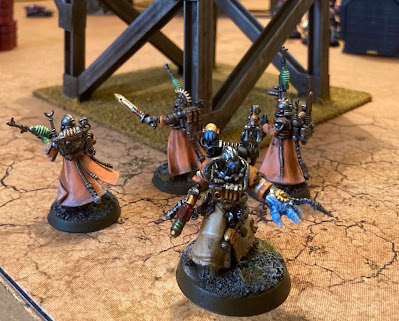Actions are a thing now. A new mechanic for 9th edition 40k, we've probably all seen them talked about and maybe used them in play, but if you are like me, you've probably also been confused by them, gotten them wrong, and tried to avoid them where possible so as not to face digging through the book to work out exactly how a specific action works. I've been using them somewhat grudgingly, but I've made enough mistakes now that I think I've got the basics down, and I think going forward they are going to be quite an important part of the game, both competitively and narratively. They provide more tactical and strategic decisions to be made and mastering how they work - how and when to perform them, and how to disrupt them will be quite a big deal. So here is my quick guide to taking actions in 40k. I'm going to put in bold some key points that I have initially missed so that you can either learn from, or laugh at my mistakes.
First thing to note, the Actions section of the rules (on page 258 in my rulebook) details the main rules for regular actions and psychic actions. Seems simple enough? Psychic actions are basically psychic powers, except your psyker cannot cast any other powers at the same time. Actions are basically a unit stands there and does nothing for a bit. Well there are a couple of important notes here for the regular actions that I've missed in my games, and there is also the fact that each action specifies when and where it starts and ends, as well as which units can perform them, meaning you will need to check each one to see what it does.
Let's look at exactly what you can and can't do while performing an action. Firstly, it's important to note that your unit cannot start to perform an action while within engagement range of the enemy - but crucially, being in engagement range does not stop the action from being completed. I've definitely got this one wrong, thinking that breaking the initial criteria for an action will stop the action - it is not the case! This also seems to apply to the individual actions - for example the Siphon Power action from The Four Pillars mission states that to start it, there must not be enemy units in range of the objective marker, but it doesn't say anything about enemy units moving into range stopping the action from occurring. I believe we were playing under the impression that it would stop the action during this game, though I think various failed charges stopped it becoming an issue.
Also in terms of things you can and can't do - even though most actions are done at the end of the movement phase, a unit cannot start an action if it has advanced or fallen back. Once it has started the action, it cannot move (in pretty much any way), shoot, charge, do psychic powers and cannot use it's aura abilities if it's a character, but notably it can fight in the fight phase if it is charged. (More accurately, it can do these things, but doing so makes the action fail - you might decide in your shooting phase that actually you really need to kill that last guy in a unit, rather than raising the banner.) We got both of these wrong in this game, with falling back units trying to pick up the relic, and then failing once engaged in combat. Luckily these two kind of cancelled each other out, and the result of the game was not dependant on either.
The last thing I'd like to mention is, when looking at the specific actions and when they occur, it's fairly clear that not all actions end at the same time, many are completed at the end of your turn, but at the end of your next command phase is a common one as well, but it might not be immediately obvious that individual actions specify when a unit can start performing them, and what type of unit can do so. The vast majority of them are started at the end of your movement phase - allowing you to position your units for them during your turn, but there are others, notably the Raze Objective action from the Scorched Earth mission that work differently, in this case at the start of your movement phase. We were very nearly caught out by this in this game, but we both decided not to use the associated secondary objective after we read the rule more carefully. Similarly most actions can be taken by any unit (though frequently not aircraft), but some specify infantry, characters etc.
So that's my little summary of the things I got wrong about the action rules. I'm sure anyone who is a die hard matched play gamer will have already worked all this out, but I suspect there's a fair few people out there who are like me and were initially confused by the somewhat scattered nature of the rules. I hope this helps someone out there to understand the rule better and to work out how to make use of it during their games. Thanks for reading, stay safe.





Nice one, helped me out
ReplyDelete